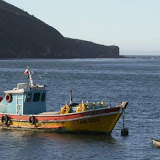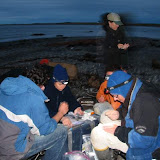
The moment we stepped out of the plane on Friday 2/3, we knew Chiloe Island would be the exact opposite of Bahia Lomas. The warm air carried by a gently breeze smelled of lush vegetation and the sea. Jorge Valenzuela, a Chilean grad student and Luis Espinosa a retired Chilean teacher met us at Puerto Montt airport. Both have done extensive work on shorebirds on Chiloe Island and are familiar with its birds and landscape. After a short drive from the airport, and a ferry ride to Anclud we were on our way to Castro, a small city which is the provincial capital on the east coast of the island. Chiloe is lush because it rains often during most of the year except in January and February when the weather is warm and relatively dry. The countryside rises and falls in hills covered with small pastures and woodlands. Dairy farming dominates the island. In the distance to the east, we could see the imposing snow-covered peaks of the Andes and a smaller coastal range to the west. As we traveled south the landscape became more rural and attractive.
After a night in the Hotel Esmeralda in the heart of Castro, the team assembled at Jorge’s house on Saturday morning. It included Humphrey, Mark, Mandy and I, along with Brad Andres and Jim Johnson all from the US, Canada and England and Jorge, his wife Daniela from Chiloe. Later we were joined by Luis Espinosa, Julissa Jeria, a biologist from SAG and Gabriel Huenun an undergrad carrying out benthic studies. By mid-afternoon, we had a net set on Pullao Bay in site of 6,000 Hudsonian Godwits and 400 Whimbrel. We chose to set the small net using igniters and black powder acquired by Jorge, no small job in Chile where such materials are tightly controlled. In the US, we can acquire black gunpowder freely in any amount in most stores selling outdoor equipment. It took Jorge a big effort involving much bureaucracy to acquire gunpowder in Chile.
The powder turned out to be slightly less powerful than we normally use and the net fired short of the mark. We caught 11 birds; 8 godwits and 3 Whimbrel. The catch was useful because we recognized a number of inadequacies that would cause much larger problems in a big catch. The next morning we resolved those problems, we made brand new keeping catches after a shopping spree in Castro in a hardware store out of a Norman Rockwell painting. We increased our charge in the cannons by about 15%, and created a covering cloth that we would use to cover the bird in the net to calm them. We were all set for the next catching attempt.
On Sunday morning, we set the cannon net beneath a near cloudless sky on a small bay just north of Castro. In the distance, we saw hundreds of floating structures associated with intensive shellfish farming dotting the channel. In bays with deeper water, there were circular pens to hold farmed salmon and in the shallows the locals farm seaweed, often used in the US as a filler in prepared foods. The tide in Pullao Bay has a range of about 6 meters, more than the Delaware Bay (2 meters) but less than Bahia Lomas (10 meters). We set the net just back from where we expected the tide to come about 3 hours ahead of high water. Within an hour we had over 6,000 Hudsonian Godwits and 200 Whimbrels being pushed towards the net by the rising tide. But they were very restless, persistently taking off and landing, sometimes flying to a different part of the shore. After a considerable time and patient “twinkling” (gently nudging the birds towards the catching area), we caught 101 birds: 98 Hudsonian Godwits, one Whimbrel and 2 Red Knots. None had been previously banded.
With this catch and the small one of the previous day, we achieved one of our primary goals: at least 100 Hudsonian Godwits for Jim Johnson’s proposed PhD project, which will focus on several issues, especially the relationship between the Hudsonian Godwits breeding around Hudson Bay and the population breeding in Alaska. The migratory ecology of this godwit species is poorly known. A key question is: do Alaska birds winter here and Hudson Bay birds in Bahia Lomas, or do they mix? Even less is known of their migratory pathways and critical stopovers. As Brad put it in his justification of the work, it would be best to accomplish this work before a problem arises as opposed to after as happened in the case of the Red Knot. Not knowing the wintering areas, the population sizes and the key stopover sites caused significant delay in responding to the decline of Red Knot populations and allowed marine fishery interests to continue the horseshoe crab harvest long after it should have been restricted. After many years of hard work by our team and others we now know these basics of knot population ecology but disentangling them from the catastrophic decline in knot numbers made them difficult to understand. Our work here will help Brad and Jim to avoid this same problem in relation to Hudsonian Godwits.
The two captured Red Knots were a bonus. We hope to catch a few of the 200 knots known to occur on the island because it may give us a clue as to which of the two subspecies that winters in the Americas occurs here. Calidris canutus rufa, the eastern New World Red Knot, breeds in the eastern Canadian Arctic, and C.c. roselaari breeds in Alaska. Our work has focused on C.c. rufa and it is proposed for federal listing as threatened or endangered. Little is known of the western subspecies, including the location of primary wintering areas and stopovers. The population is thought to have declined from original estimates of 150,000 to 20,000 so it too may need to be considered for federal listing. The two birds we caught may be either C.c. rufa, or C.c. rosalarii, but only genetic tests will make it clear.









